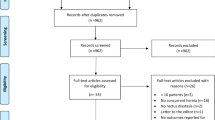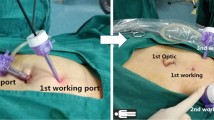Abstract
Background
A subcutaneous endoscopic onlay repair for ventral hernia with an anterior plication of diastasis recti (DR) has been published under different names in different countries. The aim of this systematic review is to assess the safety and feasibility of different named techniques with the same surgical concept.
Methods
The PRISMA guidelines were followed during all stages of this systematic review. The MINORS score system was used to perform qualitative assessment of all studies included in this review. Recommendations were then summarized for the following pre-defined key items: protocol, research question, search strategy, study eligibility, data extraction, study designs, risk of bias, publication bias, heterogeneity, and statistical analysis.
Results
The systematic literature search found 2548 articles, 317 of which were duplicates and excluded from analysis. The titles and abstracts from the remaining 2231 articles were assessed. After careful evaluation, 2125 articles were determined to be unrelated to our study and subsequently excluded. The full text of the remaining 106 articles was thoroughly assessed. Case reports, editorials, letters to the editor, and general reviews were then excluded. A total of 13 articles were ultimately included for this review, describing a similar subcutaneous endoscopic approach for repair of concomitant ventral hernias and rectus diastasis defined under nine different named techniques on 716 patients. The number of patients in those studies varied from 10 to 201. The mean operative time varied from 68.5 to 195 min. The most common complication was seroma, followed by pain requiring intervention, hematoma, and surgical site infection.
Conclusions
There are a few technique variations described in different studies, but with no significant differences in outcomes. We, therefore, propose to unify these procedures under one term, ENDoscopic Onlay Repair (ENDOR). This technique has shown to be effective and safe, with seroma being the most common complication.

Similar content being viewed by others
References
Bittner R, Bain K, Bansal VK, Berrevoet F, Bingener-Casey J, Chen D et al (2019) Update of guidelines for laparoscopic treatment of ventral and incisional abdominal wall hernias (International Endohernia Society (IEHS))-Part A. Surg Endosc 33(10):3069–3139
Bittner R, Bain K, Bansal VK, Berrevoet F, Bingener-Casey J, Chen D et al (2019) Update of guidelines for laparoscopic treatment of ventral and incisional abdominal wall hernias (International Endohernia Society (IEHS)): Part B. Surg Endosc 33(11):3511–3549
Henriksen NA, Kaufmann R, Simons MP, Berrevoet F, East B, Fischer J et al (2020) EHS and AHS guidelines for treatment of primary ventral hernias in rare locations or special circumstances. BJS Open 4(2):342–353
Dey A (2020) Abbreviations and synonyms of various surgical techniques in management of rectal diastasis with primary ventral hernias. Hernia. https://doi.org/10.1007/s10029-020-02327-y
Sharma A, Berger D (2018) The current role of laparoscopic IPOM repair in abdominal wall reconstruction. Hernia 22(5):739–741
Wiessner R, Vorwerk T, Tolla-Jensen C, Gehring A (2017) Continuous laparoscopic closure of the linea alba with barbed sutures combined with laparoscopic mesh implantation (IPOM plus repair) as a new technique for treatment of abdominal hernias. Front Surg 4:62
Dong CT, Sreeramoju P, Pechman DM, Weithorn D, Camacho D, Malcher F (2020) Subcutaneous onlay endoscopic approach (SCOLA) mesh repair for small midline ventral hernias with diastasis recti: an initial US experience. Surg Endosc. https://doi.org/10.1007/s00464-020-08134-x
Corrêa MA (1995) Videoendoscopic subcutaneous techniques for aesthetic and reconstructive plastic surgery. Plast Reconstr Surg 96(2):446–453
Champault GG, Catheline JM, Barrat C (1999) Parietoscopic treatment of abdominal wall defects: a report of 15 cases. Hernia 3(1):15–18
Claus CMP, Malcher F, Cavazzola LT, Furtado M, Morrell A, Azevedo M et al (2018) Subcutaneous onlay laparoscopic approach (SCOLA) for ventral hernia and rectus abdominis diastasis repair: technical description and initial results. Arq Bras Cir Dig 31(4):e1399
Köhler G, Fischer I, Kaltenböck R, Schrittwieser R (2018) Minimal invasive linea alba reconstruction for the treatment of umbilical and epigastric hernias with coexisting rectus abdominis diastasis. J Laparoendosc Adv Surg Tech 28(10):1223–1228
Köckerling F, Botsinis MD, Rohde C, Reinpold W, Schug-Pass C (2017) Endoscopic-assisted linea alba reconstruction: new technique for treatment of symptomatic umbilical, trocar, and/or epigastric hernias with concomitant rectus abdominis diastasis. Eur Surg 49(2):71–75
BellidoLuque J, BellidoLuque A, Valdivia J, Suarez Gráu JM, Gomez Menchero J, García Moreno J et al (2015) Totally endoscopic surgery on diastasis recti associated with midline hernias. The advantages of a minimally invasive approach. Prospective cohort study. Hernia 19(3):493–5011
BellidoLuque J, BellidoLuque A, Tejada Gómez A, Morales-Conde S (2020) Totally endoscopic suprabupic approach to ventral hernia repair: advantages of a new minimally invasive procedure. Cir Esp 98(2):92–95
Barchi LC, Franciss MY, Zilberstein B (2019) Subcutaneous videosurgery for abdominal wall defects: a prospective observational study. J Laparoendosc Adv Surg Tech 29(4):523–530
JuárezMuas DM, Palmisano E, PouSantoja G, Cuccomarino S, González Higuera G, Mayo P, Martínez Maya JD, Domínguez G, Ayala Acosta JC, Chichizola A (2019) Reparación endoscópica preaponeurótica (REPA) como tratamiento de la diástasis de los músculos rectos asociada o no a hernias de la línea media. Estudio multicéntrico. Revista Hispanoamericana de Hernia 7(2):59–65
Brendel SR, Mascaró J (2020) Reparación de hernias ventrales asociadas a diástasis de músculos rectos por abordaje endoscópico Resultados preliminares. Rev Hispanoam Hernia 8(3):115–121
Medina JP, Busnelli G, Cerutti RR, Pirchi DE (2019) Subcutaneous endoscopic approach for treatment of diastasis recti, associated with other midline abdominal wall defects. Rev Argent Cir 111(1):E20–E26
Cuenca O, Rodríguez A, Segovia A (2017) Reparación endoscopica de diastasis derecto y defectos de la línea media. Cir Paraguaya 41(2):37–40
Gandhi JA, Shinde P, Kothari B, Churiwala JJ, Banker A (2020) Endoscopic pre-aponeurotic repair (EPAR) technique with meshplasty for treatment of ventral hernia and rectus abdominis diastasis. Indian J Surg. https://doi.org/10.1007/s12262-020-02189-9
Kler A, Wilson P (2020) Total endoscopic-assisted linea alba reconstruction (TESLAR) for treatment of umbilical/paraumbilical hernia and rectus abdominus diastasis is associated with unacceptable persistent seroma formation: a single centre experience. Hernia 24(6):1379–1385
Liberati A, Altman DG, Tetzlaff J, Mulrow C, Gøtzsche PC, Ioannidis JPA et al (2009) The PRISMA statement for reporting systematic reviews and meta-analyses of studies that evaluate healthcare interventions: explanation and elaboration. BMJ 339:b2700
Slim K, Nini E, Forestier D, Kwiatkowski F, Panis Y, Chipponi J (2003) Methodological index for non-randomized studies (minors): development and validation of a new instrument. ANZ J Surg 73(9):712–716
JuárezMuas DM (2019) Preaponeurotic endoscopic repair (REPA) of diastasis recti associated or not to midline hernias. Surg Endosc 33(6):1777–1782
Fiori F, Ferrara F, Gobatti D, Gentile D, Stella M (2020) Surgical treatment of diastasis recti: the importance of an overall view of the problem. Hernia. https://doi.org/10.1007/s10029-020-02252-0
Claus C, Malcher F, Cavazzola LT (2020) Comment to: TESLAR for treatment of umbilical/paraumbilical hernia and rectus abdominus diastasis is associated with unacceptable persistent seroma formation. Should subcutaneous endoscopic mesh placement be abandoned? Hernia 24(6):1411–2
Morales-Conde S (2012) A new classification for seroma after laparoscopic ventral hernia repair. Hernia 16(3):261–267
Cuccomarino S, Bonomo LD, Aprà F, Toscano A, Jannaci A (2021) Preaponeurotic endoscopic repair (REPA) of diastasis recti: a single surgeon’s experience. Surg Endosc. https://doi.org/10.1007/s00464-021-08405-1
Parker SG, Wood CPJ, Sanders DL, Windsor ACJ (2017) Nomenclature in abdominal wall hernias: is it time for consensus? World J Surg 41(10):2488–2491
Muysoms F, Jacob B (2018) International hernia collaboration consensus on nomenclature of abdominal wall hernia repair. World J Surg 42(1):302–304
Funding
No funding was received or utilized for this work.
Author information
Authors and Affiliations
Corresponding author
Ethics declarations
Disclosures
Dr Cavazzola discloses consulting fees from Strattner and Medtronic, outside the submitted work. Dr Malcher discloses consulting fees from BD & Medtronic, outside the submitted work. Drs DL Lima, RNCL Lima, C Claus, CT Dong, and P Sreeramoju disclose no financial relationships with industry or conflicts of interest.
Additional information
Publisher's Note
Springer Nature remains neutral with regard to jurisdictional claims in published maps and institutional affiliations.
Supplementary Information
Below is the link to the electronic supplementary material.
Rights and permissions
About this article
Cite this article
Malcher, F., Lima, D.L., Lima, R.N. et al. Endoscopic onlay repair for ventral hernia and rectus abdominis diastasis repair: Why so many different names for the same procedure? A qualitative systematic review. Surg Endosc 35, 5414–5421 (2021). https://doi.org/10.1007/s00464-021-08560-5
Received:
Accepted:
Published:
Issue Date:
DOI: https://doi.org/10.1007/s00464-021-08560-5




